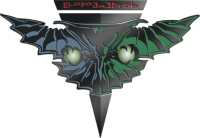Romulan
From Star Trek: Theurgy Wiki
The Romulans were a humanoid race from the planet Romulus. The Romulans were biological cousins of Vulcans, as they were descended from those who rejected Surak's reforms during the Time of Awakening. The Romulan Star Empire was the Romulan state and one of the major powers known in the galaxy.
Physiology
Due to their shared ancestry, Vulcans and Romulans possessed very similar physiology, including varied skin color. Romulans had pointed ears, eyebrows that were arched and up-swept, and copper-based blood that appeared green when oxygenated in the arteries, or copper or rust-colored when deoxygenated in the veins. Most Romulans had two brow ridges above the bridge of their nose, forming a V-shape on the forehead. However, a minority of Romulans lack these ridges, making them outwardly indistinguishable from Vulcans. In addition, like their biological cousins, Romulans did possess greater physical strength than that of a Human.
The Romulan heart is gray in color.
Despite their common ancestry there were also many subtle internal physiological differences between Vulcans and Romulans. Their life signs registered distinctly enough on the scanners of the USS Enterprise in 2268 that officer Pavel Chekov was able to distinguish his crewmate Spock from the crew complement of a Romulan starship, though he did note the difficulty of the task.
The physical differences between Romulans and Vulcans were evidenced in Dr. Beverly Crusher's failed attempt to treat a Romulan, Patahk, who had suffered advanced synaptic breakdown, with the methods used to treat Vulcans. In fact, it was later determined that the genetic similarities between Romulans and Klingons allowed for the two species to have a compatible ribosome match to effect treatment.
Romulans were known to often be interfertile with Humans and Klingons, which was evident in the existence of both Nathaniel Isley and Devyrie Okhala.
Psychology
Romulans lacked the rigorous mental disciplines developed by the followers of Surak. They were a passionate people, easily moved to extreme emotions.
As an expansionist power, the Romulan Star Empire claimed vast tracts of space that were outside its effective authority, for example Sector 25434. These claims were not recognized by other governments. Romulans seldom gave up territory once they had seized it. In the mid-22nd century, the Romulans used cloaked mines to assert new territorial claims. The Romulans believed their destiny to be the domination of the entire Milky Way Galaxy.
Customs & Culture
In Romulan society, military/political rank influences social standing. Because Romulans were members of a militaristic civilization, who considered defending the Romulan Empire and their own personal honor of foremost importance, military service and its accompanying rank were decisive factors in determining social eminence. However, while the military played an important role in Romulan society, it was the Romulan Senate that controlled the government.
At one point in history, Romulus was a sovereign nation ruled by an Empress, as indicated by Q. By the 23rd century, the highest position of power was held by the Praetor, who presided over the Romulan Senate. The Praetor headed the Continuing Committee, which was comprised of the Empire's most elite individuals, who made decisions of the utmost importance.
By the 24th century, the government of Romulus was dependent upon the Tal Shiar, the Romulan secret police, to maintain order and stability among both civilians and the military. The Tal Shiar was known for its brutal tactics, which included routine kidnapping, torture, and assassination. Many Romulans feared even expressing dissenting opinions in order to not bring the attention of the Tal Shiar. There were also indications that tension existed between the military and the Tal Shiar.
Romulan society was based upon a highly structured caste system. Unlike most of the highly evolved species in the Alpha/Beta Quadrant, Romulans still practiced slavery, in this case of the Remans, which they used for slave labor and as shock troops.
Romulans tended to be highly xenophobic, engaging in extended periods of isolationism, and could be perceived as outright racist to other species, believing themselves to be superior. At least some Romulans believed that, one day, the Romulan Empire would rule the entire galaxy and that Humans would be extinct. According to Miles O'Brien, there was no piece of technology in existence that the Romulans didn't claim they invented before everyone else.
Both males and females could command warships, obtain high political positions, and could be members of the Tal Shiar.
Like the Vulcans, the Romulans gave up unrestrained violence as a way of life. However, in the case of the Romulans, this was replaced with a controlled deviousness: as a species, the Romulans were generally thought of as duplicitous, a reputation reinforced by the actions of their government over time. During the 23rd century, Romulans practiced the death penalty on criminals by means both painful and unpleasant. Prior to the presenting of the charges, the Romulans allowed the accused a Right of Statement.
Reluctance to rely on overt hostility generally led the Romulans to play a waiting game with their opponents, attempting to manipulate an adversary into breaking – or appearing to break – an agreement so as to give them a solid justification for striking. They were also well-known for fearing disgrace over death. With this frame of mind, Romulan parents disposed of any newborn carrying birth defects, as the alternative would mean a waste of resources.
The totalitarian nature of Romulan society, in which dissent was often a crime and Romulan security officers masqueraded as citizens, led many Romulans to be extremely paranoid.
A common Romulan courtesy was the saying "Jolan Tru", although what exactly this meant is unclear, as it was used in the context of both a greeting and farewell, much like the word "Aloha" on Earth's Hawaiian Islands.
Food and beverages
Kali-fal was a very aromatic Romulan beverage that was said to forcibly open one's sinuses well before the first sip. In 2374, Captain Benjamin Sisko offered Senator Vreenak a glass of replicated kali-fal, which the Senator found to be a "fair approximation" but "somewhat lacking in aroma."
The jumbo Romulan mollusk was a gourmet delicacy from Romulus which was unavailable on Vulcan. Quark served jumbo Romulan mollusks to the Vulcan gun runner Sakonna in 2370 during a "business meal".
An osol twist was a Romulan confection that was said to be very tart. In 2375, Romulan Senator Cretak suggested that Kira Nerys try an osol twist when she had remarked that jumja sticks were too sweet for her liking.
Romulan ale was a highly intoxicating alcoholic beverage of Romulan origin with a characteristic blue color (ranging from a pale sky blue to a dark midnight blue). It took a while to ferment and Doctor Leonard McCoy joked that he used it for "medicinal purposes." Romulan ale was a challenge even for species as stout as the Klingons, who were usually quite resistant to the effects of alcohol.
Viinerine was a traditional Romulan food served in the military. It was served aboard the IRW Khazara in 2369, during an officers' meal attended by Deanna Troi, who was posing as Major Rakal of the Tal Shiar. When it was offered to her by Commander Toreth, Troi picked up a different dish, not knowing which contained viinerine. When the Khazara's commander told her she should have tried it, Troi said that she had "smelled better viinerine on prison ships."
History
The Romulans originated from dissident Vulcans who rejected Surak's philosophy of peace, during the Time of Awakening and emigrated from their homeworld around the 4th century. They settled on the planets Romulus and Remus, subjugating the native Remans in the process. The development of warp drive enabled the Romulans to expand their state into a Star Empire.
In 2152, the Romulans came into contact with the Human starship Enterprise. Relations between the Empire and United Earth deteriorated as the Enterprise crew thwarted a Romulan plot to subvert the Vulcan High Command. Recognizing the growing threat posed by Earth, the Romulans attempted to incite war in the region by attacking civilian shipping using disguised drones. The effort, however, backfired, as their involvement was exposed by Enterprise and spurred the formation of an alliance between the Humans, Vulcans, Andorians, and Tellarites, the nucleus of what would become the United Federation of Planets.
Open war erupted between Earth and the Romulans in 2156, ending four years later with a humiliating Romulan defeat at the Battle of Cheron. An ensuing peace treaty established the Romulan Neutral Zone, after which the Romulans had no substantial contact with Humans for a century. In 2266, the Romulans tested Federation resolve by sending a Bird-of-Prey to attack Federation outposts along the Neutral Zone. The defeat of the Bird-of-Prey by the USS Enterprise averted war. During this period, the Romulans experienced a short-lived break in their enmity with the Klingons, resulting in a technological exchange between the two.
The Romulans viewed the 2293 Khitomer Accords between the Federation and the Klingon Empire unfavorably, as it shifted the balance of power against them. Escalating hostilities between the Star Empire and the Federation culminated in the Tomed Incident of 2311 and the Treaty of Algeron. The Romulans again ceased meaningful contact with the Federation, though they continued to war intermittently with the Klingons. In 2364, the Empire began to engage once more with the Federation, following a series of mysterious attacks on their Neutral Zone outposts.
For the latter part of the 2360s, the Romulans were locked in a cold war with the Federation, launching repeated probes of Federation space and subversive actions. Most significantly, they attempted to break the Federation-Klingon alliance, resulting in the Klingon Civil War, and to exploit the Vulcan reunification movement to invade Vulcan. Both plans were unsuccessful. The Empire's position shifted when violent contact with the Dominion in 2370 presented a common threat to all Alpha Quadrant powers. The Romulans collaborated with Starfleet in a limited fashion to counter the Dominion threat, though ultimately they opted to sign a nonaggression pact with the Dominion in late 2373.
In mid-2374, the Romulans were brought into the Dominion War on the Allied side through an act of subterfuge by Benjamin Sisko and Elim Garak. Romulan participation marked a turning point in the war and was critical to the defeat of the Dominion, the following year.
In the 24th century, a dissident movement began to gain momentum, based on the desire to learn about Vulcan and their ideals. The movement's ultimate goal was the reunification of Romulus and Vulcan. Ambassador Spock was deeply involved in this movement.
In the war's aftermath,in a failed plot to destroy the Federation, Romulan Praetor Shinzon was defeated at the Battle of the Bassen Rift, leaving Senator Tal’aura to take the reigns as the new Praetor of the Romulan Star Empire, with the support of Fleet Commander Tomalak. Commander Donatra of the Warbird Valdore had openly opposed the new Praetor, and began a rebellion backed by the strength of the Romulan 3rd and 5th Fleets. Additionally, the Reman people openly demanded a continent on Romulus and reparations for hundreds of years of slavery, which was denied them.
A Romulan blockade of Remus was the Praetor’s reply, as well as cutting food and medical supplies to the sister planet. Affairs within Romulan space have deteriorated quickly for the Federation; with the continued Reman upheaval and skirmishes with Donatra’s opposition fleet. Open Civil War began in 2380 when Donatra was able to capture and hold a number of key agricultural worlds, establishing the Imperial Romulan State.
Government
The ruling body of the Romulan Star Empire was the Romulan Senate, with each senator representing a province. The Senate was led by the Praetor, followed by the Proconsul and then the Vice-proconsul. The Praetor also presided over the Continuing Committee, a powerful body that held authority over Senate members. Changes of government and attendant shifts in policy were not uncommon in the Empire. In 2373, Q contemplated producing a child with the Romulan empress.
The Romulan Senate dispatched ambassadors from time to time, for example Caithlin Dar to Nimbus III and Nanclus to the United Federation of Planets.
Foreign Relations & Military
In external application, Romulan political agendas appeared largely unified over the centuries. Their goals focused on maintaining Imperial security through vigilance, and negating the perceived advantages of their rivals. Both goals were accompanied by a near-paranoid reticence to reveal information, even facts as basic as their racial identity, that might illuminate other Romulan ambitions or motivations.
The Romulan military was a powerful and technologically advanced force encompassing both spacefaring and ground forces. Despite being defeated by Earth in the Earth-Romulan War of the 2150s, the Romulan Star Empire continued to be a powerful presence, not afraid to tempt Starfleet by entering the Neutral Zone. Romulan forces were a deciding factor in the Dominion War, whose entry in 2374 turned the tide of war in favor of the Allies.
Romulan military operations were supported by the War Plans Council, a high-level government agency.
Besides regular forces, the Romulan Tal Shiar also had its own fleet of starships, and were a ruthless and powerful organization within the Empire and beyond.
Romulan Technology
Romulan technology was often cited as one of the reasons why the Romulan Star Empire was regarded as such a dangerous foe in times of war. The Romulan Ministry of Science oversaw the scientific research of the Romulan Star Empire. The Romulan Astrophysical Academy was a division within the Romulan science community. The Romulans were known to have developed a multitude of different technologies that are either the first of their kind or unique to the Romulan Star Empire.
Cloaking Technology
The Romulans were the first known race to develop the cloaking device stealth technology, first observed on Romulan mines and the Romulan Bird-of-Prey in 2152.
The Romulans and the Federation long engaged in a tech war of cloak and cloak detection. In 2152, a quantum beacon proved an effective counter measure for detecting less advanced cloaks such as those found on Romulan mines, but not those on early Romulan Birds-of-Prey. In 2368, the Federation developed the tachyon detection grid, a technique that allowed for the detection of Romulan vessels of the day.
By 2379, the Star Empire had perfected the cloaking technology. The cloak of the Reman Warbird Scimitar produced no tachyon emissions and left no residual antiproton traces for detection. The Scimitar was the only vessel in the Star Empire known to have overcome the long standing problem of not being able to raise shields or fire weapons when the cloaking device was active. The only known way to counter these latest cloaks involved the use of telepathic races such as Betazoids to detect an enemy crew by sensing their thoughts.
Disruptors
Romulan energy weapons were described by Spock in 2266 as being superior to those of the Federation. The Romulans were one of three races, along with the Klingons and the Breen, who were known to use the type 3 disruptor. When fired, a Romulan disruptor left behind residual antiproton particles that remained for several hours.
Plasma Torpedoes
First known to have been used by the Romulans in 2266, plasma torpedoes were an extremely powerful but an energy-intensive weapon system. This type of high-energy plasma weapon was first encountered by Starfleet when a Romulan Bird-of-Prey destroyed several Federation outposts near the Romulan Neutral Zone.
Upon detonation, the torpedo unleashed an overpowering energy plasma that caused an implosion in the target. Even rodinium, the hardest material known to the Federation, could not withstand this kind of attack. A single torpedo was capable of catastrophic damage and its destructive potential against fortified targets was unmatched.
The torpedo was capable of going into warp, but the effective damage output decreased the longer it was in flight. If the torpedo had a flaw--it was limited by range, such as when the Bird-of-Prey fired on the USS Enterprise, the Starfleet vessel was able to maneuver out of its most effective range, so that when it did hit them, its effectiveness had dissipated and the damage to the Enterprise was fairly minor.
The only other races to have used plasma torpedoes are the Kazon and the Cardassians, but the first documented usage of plasma torpedoes by these races occurred more than a century after the Romulans, in the early 2370s.
Shields
Standard Romulan deflector shields were believed to be at least on par with those of the Federation. However, the most advanced example of shield technology in the Romulan Star Empire was present on the Scimitar, which was equipped with both primary and secondary shields. The ship endured at least thirty-two phaser hits, twenty disruptor strikes, and twenty torpedo impacts in a single engagement at the Battle of the Bassen Rift, exhausting the weapons complement of the Enterprise-E, and was still able to maintain 70% shield strength.
Self-Repair Technology
The Romulans were known to be able to equip their ships with a self-repair technology, principally used on the Romulan drone ship in 2154.
Quantum Singularity Propulsion
In the 24th century, an artificial quantum singularity served as the primary power source for large Romulan spacecraft, such as the D'deridex-class Warbird. Once activated, the singularity core could not be shut down.
Source 1: Memory Alpha
Source 2: Memory Alpha
Source 3: Memory Alpha



